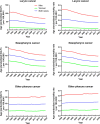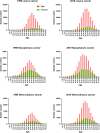Global trend and risk factors of the disease burden for pharynx and larynx cancers between 1990 and 2019: a systematic analysis of the global burden of disease study 2019
- PMID: 36443799
- PMCID: PMC9703662
- DOI: 10.1186/s12889-022-14654-z
Global trend and risk factors of the disease burden for pharynx and larynx cancers between 1990 and 2019: a systematic analysis of the global burden of disease study 2019
Abstract
Background: Pharynx and larynx cancers (PLCs) are the top killer cancers in head and neck and significantly affect the quality of life of patients. A detailed study examining the disease burden and risk factors of PLCs is lacking.
Methods: Data on mortality and disability-adjusted life-years (DALYs) were extracted from the Global Burden of Disease Study 2019. The estimated annual percentage change (EAPC) of the age-standardized mortality rate was calculated using a generalized linear model with a Gaussian distribution. Mortality and DALYs were stratified according to the sociodemographic index (SDI), age, gender, and risk factors. The association between the SDI and mortality rate was measured using Spearman's correlation.
Results: Between 1990 and 2019, the total number of deaths due to PLCs increased by 60.7% (95% confidence intervals: 39.32 to 66.8), from 192.38 thousand in 1990 to 309.16 thousand in 2019, and the total DALYs due to PLCs increased by 49.41% (95% confidence intervals: 30.15 to 53.27), from 5.91 million in 1990 to 8.83 million in 2019. The age-standardized mortality rate declined for larynx cancer (from 2.19 in 1990 to 1.49 in 2019) and nasopharynx cancer (1.26 to 0.86) but increased slightly for other pharynx cancer (1.25 to 1.37). The death number of PLCs was significantly higher in men aged 50 to 70 years, which accounts for 46.05% and 43.83% of the total deaths in 1990 and 2019, respectively. Low and low-middle countries had the greatest age-standardized mortality rate for larynx and other pharynx cancer, while low-middle and middle countries dominated for nasopharynx cancer. The leading risk factors for PLCs were smoking and alcohol use, which account for 37.92% and 58.84% in total DALYs rate of PLCs, and the influence of risk factors was significant in men.
Conclusion: The total number of deaths and DALYs due to PLCs increased from 1990 to 2019. Countries with relatively low SDI and middle-aged and older men had the greatest burden of PLCs. Building better health care systems in relatively low SDI countries and improving strategies of smoking and alcohol control should be a priority in health policy.
Keywords: Burden of disease; Global burden of disease study; Pharynx and larynx cancers; Public health; Risk factor.
© 2022. The Author(s).
Conflict of interest statement
All authors declare there is no competing interest.
Figures





References
-
- Mahalingam S, Spielmann P. Quality of life outcomes following treatment of Hypopharyngeal Cancer. Adv Otorhinolaryngol. 2019;83:126–134. - PubMed
-
- Reitsma MB, Kendrick PJ, Ababneh E, Abbafati C, Abbasi-Kangevari M, Abdoli A, Abedi A, Abhilash ES, Abila DB, Aboyans V, Abu-Rmeileh NM. Spatial, temporal, and demographic patterns in prevalence of smoking tobacco use and attributable disease burden in 204 countries and territories, 1990-2019: a systematic analysis from the global burden of disease study 2019. Lancet. 2021;397(10292):2337–2360. doi: 10.1016/S0140-6736(21)01169-7. - DOI - PMC - PubMed
Publication types
MeSH terms
LinkOut - more resources
Full Text Sources
Medical

